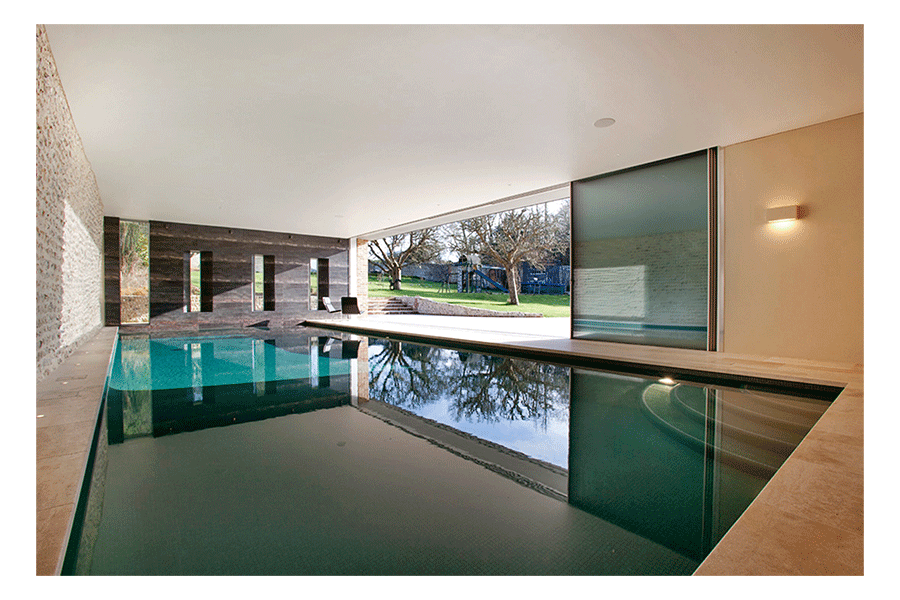From ingenious indoor/outdoor pools to subterranean sanctuaries, these residential projects make a big splash on the design front.
Going underground
The owners of this Notting Hill townhouse enlisted west London’s 23+GS/318 Architects to realise their dream home spa, and for that, they had to go underground. But with both space and sunshine at a premium in the Capital, creating an airy and light-filled subterranean leisure complex is no mean feat. Stuart Robertson, the studio’s design director says: “For us, the key to the success of underground spaces is the quality of space, light and air providing a calm and serene retreat: timeless, eternal, style over fashion… High quality natural materials, and smooth and simple surfaces without unnecessary ornamentation allow for a feeling of relaxation and escape from busy lives. Less fussiness, less glitz gives a sense of ease and of time being our companion.”
Stuart talks of the “meditative” quality of materials used in the project. A cool palette of double-height glazed and concrete-like tiled walls is complemented by polished plaster concrete finishes. But here, the man-made is offset with natural elements – not least the still blue water, which offers a sense of serenity. Imposing vertical louvres of dark stained wood are used to separate the pool from the adjoining film room and, thanks to some carefully positioned spotlights – both overhead and recessed into the seating area – there’s shifting glimpses of light that capture the texture of the grain, and the wood’s natural variations in tone.
The curvature of the huge, sloping skylights is pleasingly echoed throughout the spa, too, from the walls to the woodwork, and from the central circular jacuzzi to the curved shaping of the pool itself. “An interesting element here is also the curved concrete bench, which cuts through the glass wall presenting a striking visual metaphor as if half the bench has been submerged in water,” says Stuart. “All the elements combine to form a chapel-like restorative environment.”

Inside out
A listed flint wall, which originally formed part of the garden wall of this family home, could have been seen as a hindrance. Instead, it became a historical design feature in this otherwise stark and modern infinity pool, the handiwork of Guncast, together with architect Neil Etheridge. Guncast’s managing director Jack Harding says: “The client’s brief was for a contemporary family swimming pool that joined onto the existing property, enabling direct access between both buildings. Neil was forward-thinking and managed to develop a scheme that left intact the listed garden wall. He used a cluster of existing outbuildings to connect up and create an indoor pool, which was effectively built as a ‘lean to’ against the wall.”
The rectangular swimming pool is simple in shape but it boasts a heady mix of natural and man-made materials and a wealth of interesting textures. Here, industrial styling and clean, contemporary lines are flanked with centuries-old engineering and craftsmanship.
But the pleasing contrasts don’t stop there. Huge sliding glass doors seamlessly connect the pool with the adjoining patio area, creating a flexible indoor/outdoor space that successfully blurs the boundaries of each, while the smooth, pale stone patio acts as a direct contrast to the bumpy flint wall. “Although this was a complex build that required skilled craftsmen, an extremely well architecturally-planned pool was built for the client and their family by the team,” says Jack. “The large sliding glass door, which completely opens the pool hall to the exterior paved area, is the real element that makes this a family pool. Being able to open and enlarge the facility in this way means the garden and play areas are clearly visible from the pool, and vice versa. Effectively, the indoor and outdoor areas blur into one, which, to me, is hugely desirable.”

On the tiles
“Spa design concepts often look to engage the senses by removing distraction, so it is common to see void and muted spaces,” explains St. John’s Wood based interior designer Shalini Misra. “When I designed the spa for the basement of this London home I wanted to engage the senses through stimulation, creating moments of impact and focus that had more energy than some traditional spa settings.” Using a mix of contrasting materials including wood, concrete, chequered tiling and marble, Shalini and her team set out to create a “layered sensorial experience”. The pool and its surrounds offer all the calm and serenity you’d want from a conventional wellness setting but this is also an enlivened space, thanks to its bold design and attention-grabbing details: the chic black and white checks add interest beneath the waterline, while the patterned tiling in the steam room offers a warm Mediterranean feel.
The homeowners of the detached Italianate villa already had an enviable art collection, which Shalini worked into the design of the rest of the property. The subterranean spa is no different, with a huge, contemporary cubic artwork suspended above the pool, as well as some carefully selected wall-hung sculptural pieces. “It is unusual to see this kind of work in a spa setting,” says Shalini. “It helps to set the experience of the space apart.”
As with any basement spa, lighting is all-important. You’d be forgiven for thinking the pool area floods with natural daylight, but the skylights overhead are in fact created using clever artificial lighting that successfully mimics the real thing. Where natural light does flood in, however, is through the adjacent gym, which looks out onto a bright and verdant courtyard. “We have used mirrors both in the gym and pool area to amplify that light, and it gives the entire space a very fresh feel,” explains Shalini.
